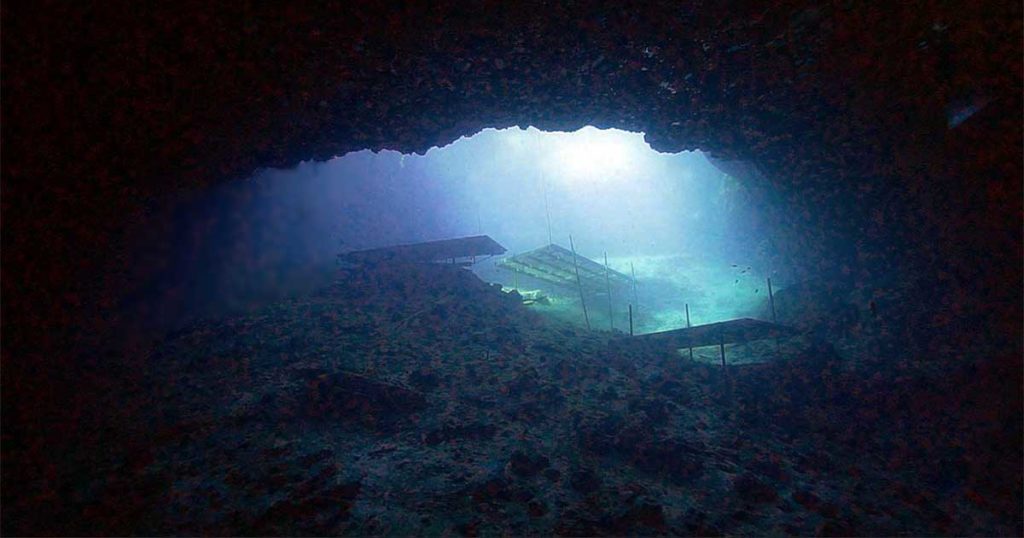According to reviews on Google and Facebook, good visibility is what visiting divers like most about Blue Grotto. It’s also what people are most likely to complain about if the visibility is not what they expected.
The photo at the top of the page shows what the Grotto can look like if people don’t stir things up. You can easily see from Peace Rock to the wall behind the dock. That’s more than 200 feet. You don’t get this kind of visibility at most Caribbean dive resorts.
This sort of clarity does not occur naturally. Sometimes Mother Nature needs a hand.
Let’s keep things moving
The water at the Grotto remains clear because natural groundwater flow brings cool, clear water from deep within the aquifer to the surface. From here, it is sucked into the underwater cave that lies beneath the far end of the parking lot.
- If the water flows, the visibility remains good. The problem is that the water doesn’t always flow.
- Groundwater levels in north-central Florida fluctuate based on recent rainfall in the aquifer’s recharge area. During the mid-1990s, an extended drought caused water levels to drop to four to five feet below what we consider normal.
- In the past few years, however, there were two occasions when the water rose over the deck. Once the water gets ankle-deep, it stops moving. This allows the sun to start warming the water.
- When water temperatures rise more than a few degrees above their normal 72 degrees Fahrenheit, algae forms and visibility drops dramatically. Fortunately, this happens only rarely.
It used to be worse
When Tom McQuarrie purchased Blue Grotto in 1963, north Florida had just experienced a series of hurricanes that dropped several feet of water on the area. This resulted in water levels rising well above anything we’ve seen in recent years.
Initially, water levels were more than halfway up the stairs leading to the parking lot. Imagine standing on the deck in water that is over your head. Obviously, this water wasn’t going anywhere.
During the winter, cold air helped keep water temperatures low. This meant the water stayed clear. However, during the summer, water temps could rise to 80 degrees or more. The resulting algae bloom turned the Grotto into a reasonable facsimile of your local rock quarry.
Tom experiments.
No one wants to drive several hours to experience visibility no better than what you can find in your local mud pit. Tom realized that his business would suffer unless he could get the algae under control.
Tom experimented with several methods to try to keep surface water temperatures low. The most successful was to pump cool water from deep within the Grotto to the surface.
Tom could have just run a large, ugly pipe up from the bottom. Instead, he got creative and installed the waterfall you see now. You may have thought this waterfall was purely decorative. It isn’t. It’s part of what helps keep the Grotto clear.
What we do today
Tom’s waterfall was only partially successful. What we do today is far more effective.
- If you stand on the dock and look over your left shoulder, you will see a large rectangular opening in the wall. This is the entrance to a channel that leads under the deck and comes out at the natural entrance to the cave that lies under the end of the parking lot.
- Ten feet from the cave entrance is a large, hydraulically driven impeller spinning at around 50 rpm. This helps ensure that water in the basin is constantly replaced by cooler, clearer water from down below. It’s effective so long as the water remains below the deck.
You might be thinking that, given how much electricity the waterfall, impeller and other pumps draw, our electric bill must be pretty steep. It isn’t. Thanks to our solar array and bank of ten Tesla Powerwall units, the sun now provides all the energy we need.
Do your part
Algae isn’t the only thing that can negatively impact visibility. Careless divers can do so as well.
It’s not a matter of how many divers are in the Grotto. We’ve seen days when there are a half-dozen or more classes in the water, yet the visibility remains surprisingly good. We have also seen situations in which a group of just four divers has decimated the visibility in the basin within 30 seconds of entering.
You can do your part in helping prevent this. Just follow the recommendations that appear in our orientation video. These include:
- Wear only enough weight to maintain neutral buoyancy in shallow water. When you dive overweighted, your feet will sink. This directs thrust from your fins toward the silt below.
- Maintain horizontal trim. Your knees should always be in line with your shoulders.
- Maintain a perpetual state of neutral buoyancy. As you swim, stop frequently. If you find yourself sinking, add air to your BC.
- If you find yourself sinking faster than you can add air to your BC to compensate, don’t kick to stay off the bottom. This just stirs up silt. Instead, remain horizontal and land with one finger on a rock. Then use your BC to regain neutral buoyancy before moving off carefully.
- Keep well away from the bottom. If you must touch down, do so only on one of the training platforms or one of the large boulders at the back of the cavern.
Following these recommendations will not only help ensure your own enjoyment, but everyone else’s as well.


